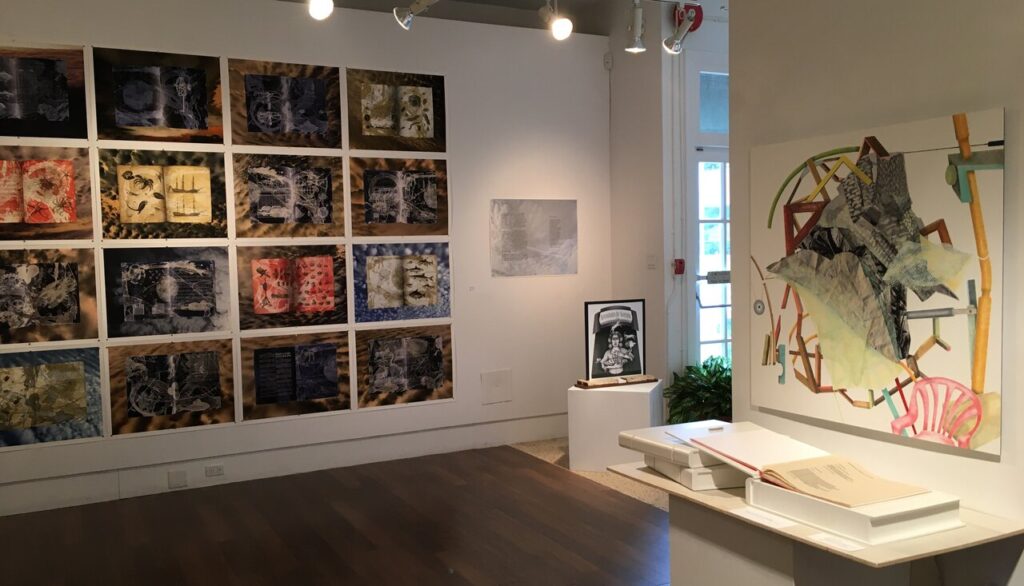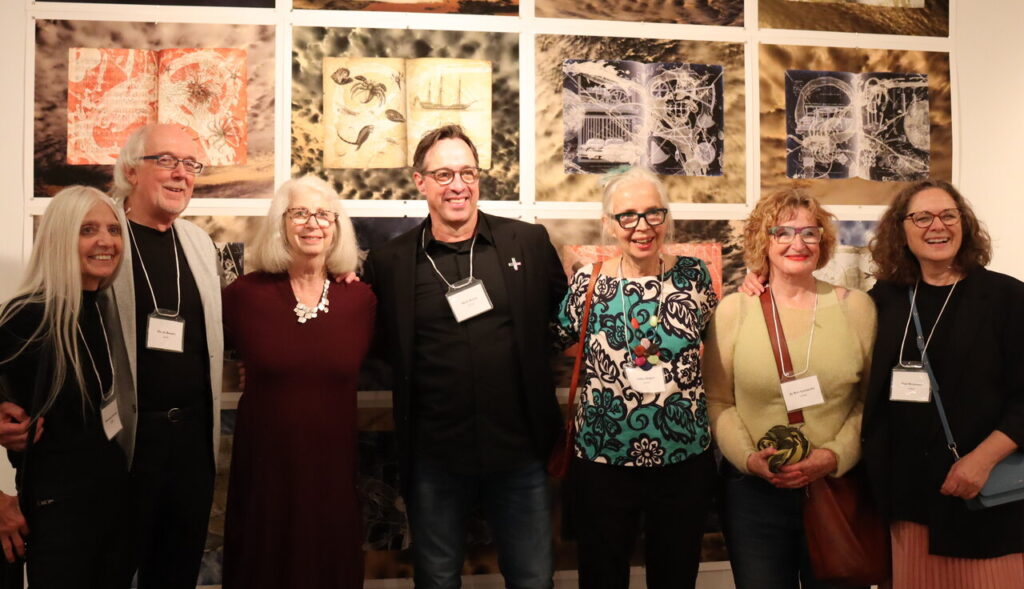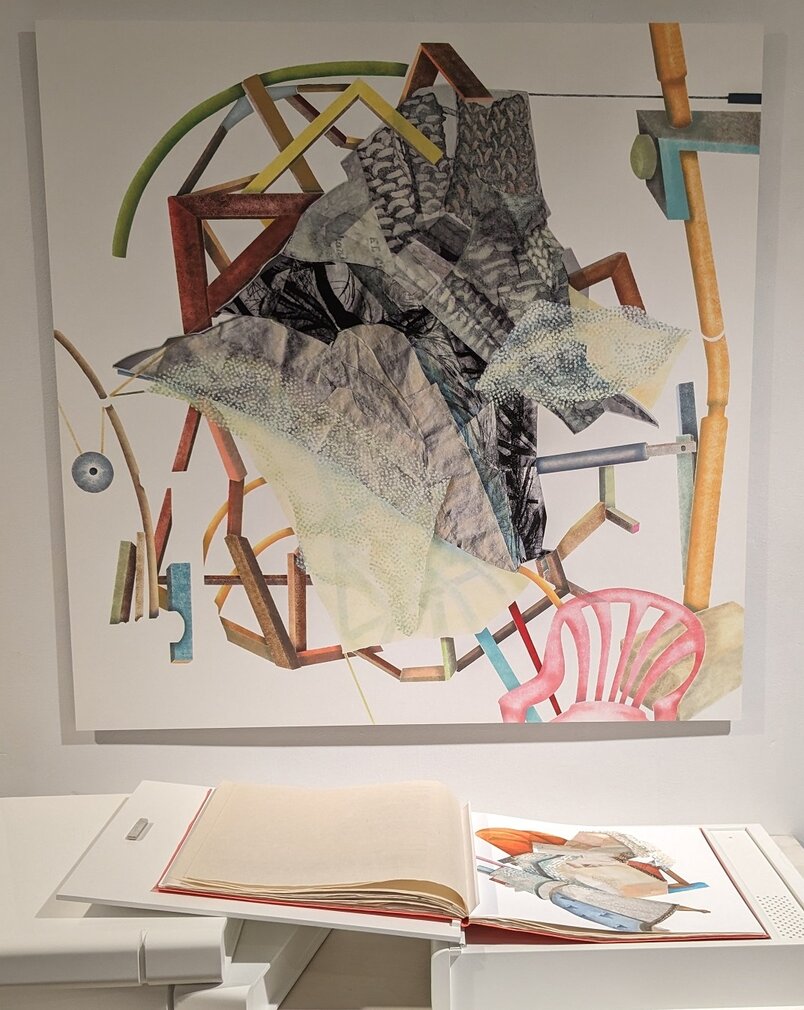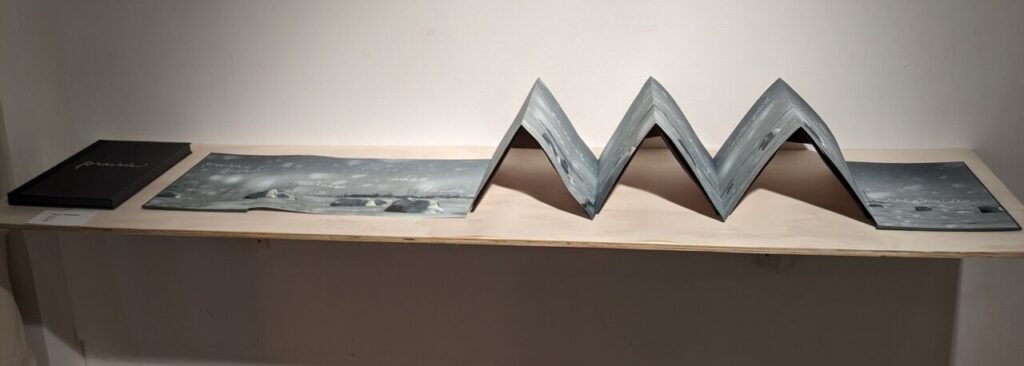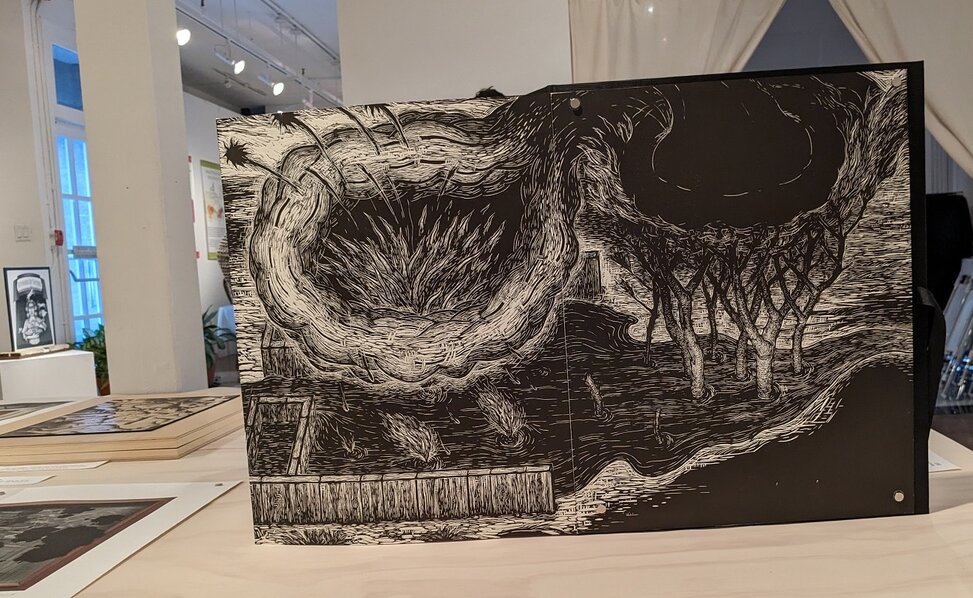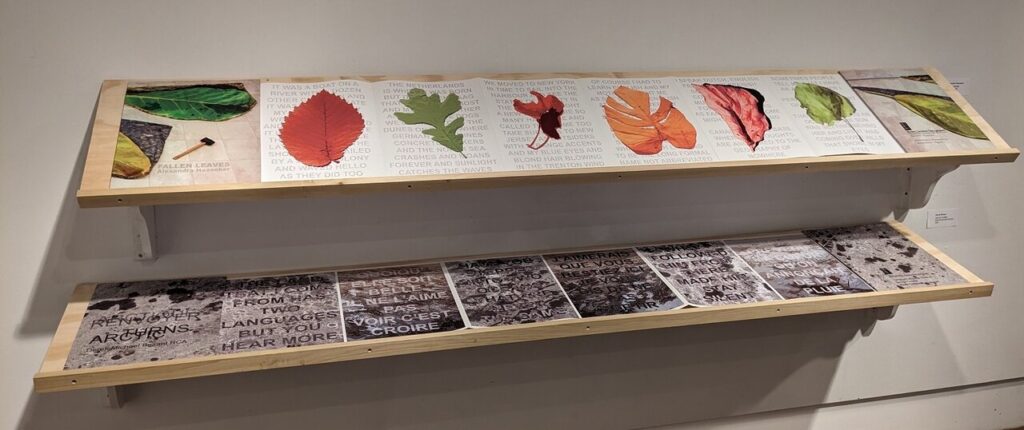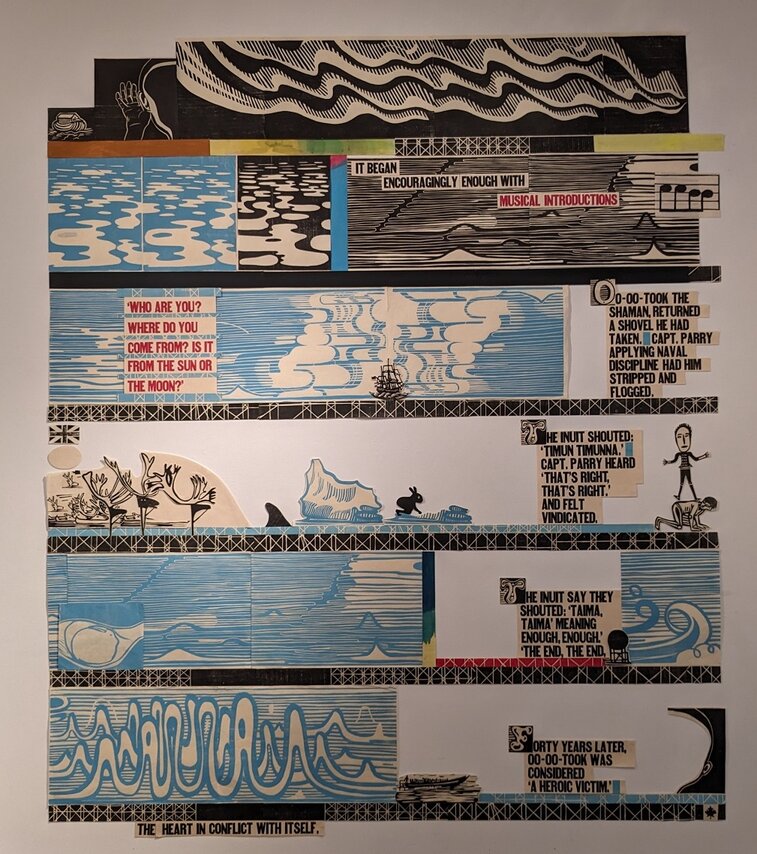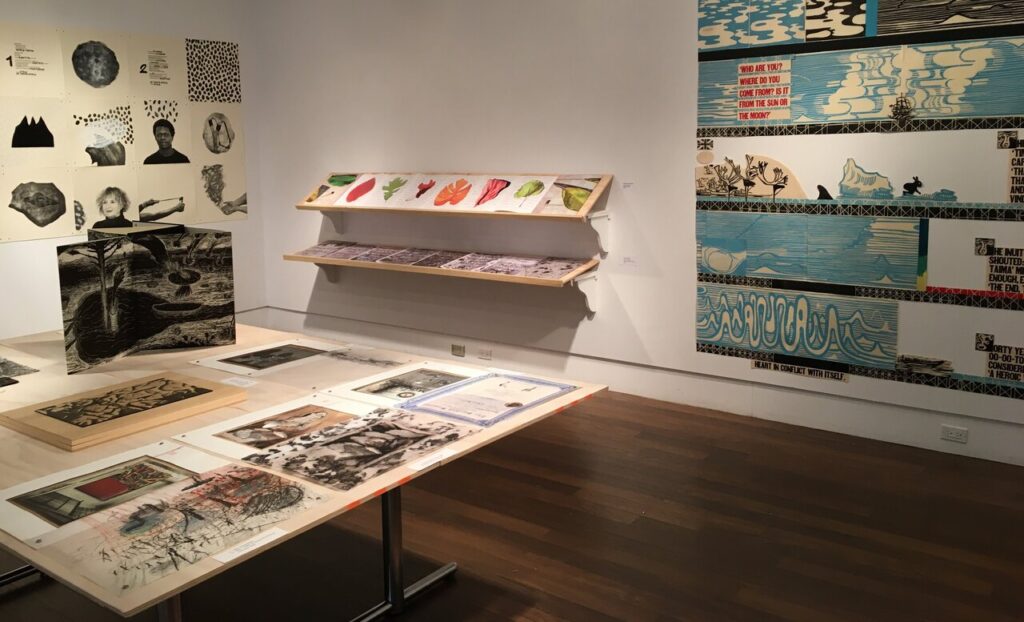The venue for this show is both untypical for art and relatively off the beaten track. It takes place on the York University’s Glendon Campus, located where Bayview and Lawrence Avenues meet. There, among the lecture halls sits the Canadian Language Museum, in a tranquil setting. The museum’s modest sized exhibiting space doesn’t normally feature artworks. But as director, Elaine Gold, explained to me, when they learned of the artists’ works and their theme, they were delighted to host them. It was a natural fit with the museum’s overall mission, namely, to highlight the many languages of Canada.
Installation view of Anthem at the Canadian Language Museum with work by (L-R) Mark Bovey, Davida Kidd an Yael Brotman
The theme of the show is Canadian identity. The participating artists were invited ‘to interrogate the meaning of the anthem’s lyrics and their relation to national and individual identity, as well as to reflect on the lands upon which they personally live, work and learn’, as their catalogue explains. The fifteen participants are Derek Besant (curator), Mark Bovey, Yael Brotman, Sean and Case Caulfield, Sue Colberg, René Derouin, Karen Dugas, Alexandra Haeseker, Libby Hague, Liz Ingram & Bernd Hildebrandt, Walter Jule, Jo Ann Lanneville, Jewel Shaw and Tracy L. Templeton. Almost all are printmakers and many are associated with the University of Alberta, either as former students or faculty. They are all very accomplished, and have exhibited extensively nationally and internationally. And this is reflected in the high quality of the work on display.
L-R: Alexandra Haeseker, Derek Besant, CLM Director Elaine Gold, Mark Bovey, Libby Hague, Jo Ann Lanneville, Yael Brotman
The works are generally in book form, and this facilitates their transportation since it is essentially a travelling show. The group has shown their work recently in Alexandria, Egypt, and after this venue – alas, the only one in Canada – it travels to Japan. Because many of the works are books, in most cases only a portion of their contents can be displayed. It is always so tempting, wandering among them, to pick one of them up and sift through its pages. But, of course, that is not possible. There are too many works to cover in this review, but here are a few highlights.
Carefully laid out under a picture are three book casings, one of which is open, revealing a hand-made book containing translations of songs and poems that are recited and heard as an audio. Yael Brotman’s piece is titled Songs We Carry, Poems We Hold. Wearing a glove provided the viewer is able in this instance to browse its delicate pages. These performers are young adults who originated from another country, and so they recite poems and sing songs from their original culture in that language, e.g., Arabic and Korean. Brotman describes these young people as ‘walking the fertile line of hyphenated identities’. Indeed, it is a reminder of the various forms of diglossia found in Canada, that is, the practice of speaking one language or dialect at home and another outside of it. That is a very common experience in this country. As well, Brotman points to a concomitant cultural diglossia in this sense, where people are part of distinctive cultures at home and in the public sphere.
Yael Brotman, Songs We Carry, Poems We Hold, 2020, etching, inkjet & stencil on Kurotani paper, wood cabinetry, audio element, 37.5 x 37.5 inches
Another issue inevitably brought up in any discussion of Canadian identity is the influence of geography, especially in terms of humanistic geography, that is, the study of the relationship between culture and geography – how they influence one another. Tracy L. Templeton, for instance, talks of topophilia, namely a love of place we develop interacting with our environment. Her work Prairie is part of an investigation of how her intimate interactions with the southern landscape of Saskatchewan, where she grew up, have influenced her. The work consists of a concertina book, partially laid out on a table for this show, that features a beautifully printed horizontal landscape. This issue is also broached by The Caulfields’ and Colberg’s book work titled Watercircle featuring wonderful black and white prints accompanied by poetry, that is inspired, again, by the Saskatchewan landscape – this time the North Saskatchewan River (Treaty 6 territory, as they note).
Tracy L. Templeton, Prairie, 2020, Digital, gold leaf, book board, foil, 82 x 40 inches
Installation view with The Caulfields’ and Colberg’s book, Watercircle, 2020, linocut and letterpress on rag paper with silk book cover, 111 x 18.25 x 3/8 inches (in front)
Another topic of this show, again almost inevitably, is the Arctic region of Canada. Talking about his contribution – a set of prints titled Arctic Turns – curator Derek Besant, remarks that while growing up ‘the concept of Canada was this land that bordered oceans on three sides…that measured out its geolographical psyche.’ And this geography, he adds, ‘remained an imagined touchstone of identity that was mostly defined by the Northern reaches as what Canada represented to me’.
Alexandra Haeseker, Fallen Leaves, 2020, UV latex ink on Mayfair, 192 x 15 x 24 inches (top) & Derek Besant, Arctic Turns, 2020, UV latex ink on Mayfair 192 x 15 x 24 inches (bottom)
It is this vast largely inaccessible region of the country that Toronto-based printmaker Libby Hague got the chance to visit recently. Greatly impressed by her experience, she ended up reading about the adventures of nineteenth century British Arctic explorer Captain William Parry. An account of his encounters with the indigenous people there, and the misunderstandings between them, is the subject of her work titled The Heart in Conflict with Itself. It is a story that, she tells us, ‘represents the best and the worst inclinations of human beings’. She aptly ends by noting: ‘Canada’s multicultural challenge is to find sufficient common ground to hold together while encouraging the immigration and diversity that is our strength’.
Libby Hague, The Heart in Conflict with Itself, 2020, woodcut installation, 102 x 78 inches
All told this is an impressive unmissable show. It is a pity that it is the only scheduled venue in Canada. We should thank the Canadian Language Museum for their foresight. It would make a wonderful exhibition at the AGO or the ROM. To my mind it is an indictment of such Canadian institutions that that is not the case.
Installation view of Anthem at the Canadian Language Museum
Huge Alcock
Images are courtesy of the Canadian Language Museum
*Exhibition information: Anthem: Expressions of Canadian Identity, October 5 – December 7, 2023, Canadian Language Museum, York University, Glendon Gallery, 2275 Bayview Ave, Toronto. Museum hours: Tue – Thurs, 11am – 4pm.

